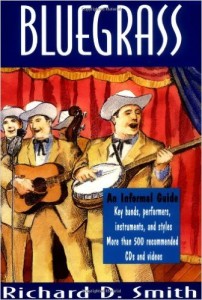Brendan Foreman penned this review.
Bluegrass music really lives a strange existence within the world of American music. Its form is too stylized and polished to classify it properly as a “folk music.” After all, the big bluegrass events of the year — MerleFest, Telluride, etc. — all feature mostly professional musicians and rarely any amateurs. Yet the average jam session at the back of any local American instrument shop will feature bluegrass as one of the main styles being played. In fact, bluegrass is probably played by more of America’s backyard mandolin-, banjo-, and guitar-pluckers than any other musical style — except maybe the blues.
Known for its reels sped up to break-neck speed as well as the “long, lonesome” tenor of its lead singers, bluegrass is generally believed to be the product of Bill Monroe. Although there were a number of other country artists — such as the Stanley Brothers and Don Reno — veering in the same direction, Monroe was the first (in 1939) to combine the traditional material and rural outlook of old-time country with the ensemble atmosphere and soloing aspect of the hot jazz groups of the Twenties and Thirties. The result was a music that was instantly appealing to the average country music lover, yet which required a great deal of musical sophistication to play well.
Since its genesis, bluegrass has managed to keep some hold of the American musical imagination, weathering both revivals and declines in popularity. By now, three to four generations worth of musicians have contributed to the bluegrass repertoire. Such a huge body of collective work can of course be incredibly daunting for the newcomer to this remarkable music. Just a sneak peek at the “bluegrass” section of your favorite record store (local or web-based) will let the reader know that the hardest question to enjoying bluegrass really is “Where to start?”
An excellent answer to this question can be found in Richard Smith’s little book Bluegrass: An Informal Guide. Smith does a very admirable job of sifting through the history of bluegrass and the thousands upon thousands of bluegrass recordings to give the new listener a place to begin collecting, learning, and loving. The tone is often tongue-in-cheek, sometimes sombre, always intelligent, but more importantly Smith imparts both an appreciation and a love for this music.
In the first chapter, Smith describes quite well what bluegrass music actually is. He even goes so far as to provide a list of the “Ten Basic Characteristics of Bluegrass.” This is mainly in order that he can distinguish bluegrass from old-time country, a common enough “mistake.” In this chapter, he also describes the instruments that are most often associated with bluegrass — violin, banjo, mandolin, acoustic guitar and bass fiddle with the occasional dobro guitar. It’s an incredibly detailed yet quick read.
The next few chapters all showcase the various bluegrass masters: Bill Monroe and His Blue Grass Boys (where the term “bluegrass” comes from); the duo Earl Scruggs and Lester Flatt, the first bluegrass hit-makers in the Forties; the Stanley Brothers, who added more of a mountain music feel to Monroe’s original bluegrass formula, among several others. Each of these chapters gives a brief history of the artists, a description of their unique sound, and a list of the recommended recordings.
Chapters Nine through Fourteen are all devoted to the current state of bluegrass music. Moving across the country, Smith details some of the best regional bluegrass bands from the Del McCoury Band in the South to the Seldom Scene of the Washington, D.C. area. Smith even manages to find some international bluegrass bands and artists such as the Russian band Kukuruza and the Japanese banjoist Kazuhiro Inaba.
Smith also devotes a chapter to highlighting the important women artists of Bluegrass, including the current stars Allison Krauss and Laurie Lewis, as well as great influencers such as Hazel Dickens and Alice Gerrard and Sara and Maybelle Carter. Unfortunately, belonging in the “A lot can happen in four years” category is Smith’s mention of the Dixie Chicks as a good example of a modern women’s bluegrass band.
Finally, Smith mentions some of the various trends that could point the way to the future of bluegrass. The jazz-influenced “New Grass” sound pioneered by Tony Trischka and Roger Sprung and continued by the likes of Bela Fleck and Sam Bush, is given ample space. He also describes the “Country ‘Grass” sounds of groups like IIIrd Tyme Out, who imbue modern country-western music with bluegrass sensibilities, and the New Traditionalist sounds of the bands such as the Johnson Mountain Boys, who make a conscious return to the original sounds of bluegrass.
Smith ends the book with a more detailed look at the instruments that make up the bluegrass sound and showcases the various masters of each. Kenny Baker on the fiddle, Jethro Burns on the mandolin, and Doc Watson on the guitar all get mentioned for their musical prowess and innovation. This chapter also highlights the various bluegrass festivals across the country that the interested listener can attend.
As the title indicates, this is a completely informal book. Smith often takes long digressions into entertaining subjects like the plethora of murder ballads in the bluegrass repertoire, the historical corporate sponsors for various famous bluegrass bands, as well as the bluegrass roots of rock ‘n’ roll. Although the experienced bluegrass listener and player may disagree with some of Smith’s opinions, it is still good for a beginner to have a place to start exploring a newly discovered music form; and the laid-back, informative approach of Smith’s book makes it an excellent candidate.
(a cappella books, 1995)

